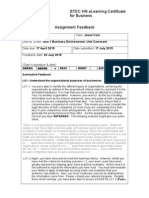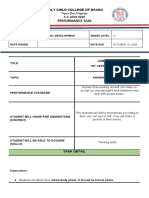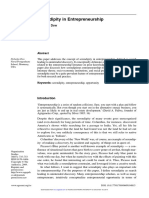MGMT3004 Entrepreneurship Assessment Guide: Assessment Task 1 - Literature Review Component
MGMT3004 Entrepreneurship Assessment Guide: Assessment Task 1 - Literature Review Component
Uploaded by
Celina LimCopyright:
Available Formats
MGMT3004 Entrepreneurship Assessment Guide: Assessment Task 1 - Literature Review Component
MGMT3004 Entrepreneurship Assessment Guide: Assessment Task 1 - Literature Review Component
Uploaded by
Celina LimOriginal Description:
Original Title
Copyright
Available Formats
Share this document
Did you find this document useful?
Is this content inappropriate?
Copyright:
Available Formats
MGMT3004 Entrepreneurship Assessment Guide: Assessment Task 1 - Literature Review Component
MGMT3004 Entrepreneurship Assessment Guide: Assessment Task 1 - Literature Review Component
Uploaded by
Celina LimCopyright:
Available Formats
MGMT3004 Entrepreneurship
Assessment Guide
The following information is designed to guide you with Assessment Task 1 for MGMT3004
Entrepreneurship. It is meant to complement the details in the unit outline so don’t forget to read the
outline as well. This includes the marking guides for your assessments. The information provided in
this guide is broken down according to what is required for the Literature Review assignment. Please
read through it carefully and ask your instructors if you have any further questions.
Assessment Task 1 - Literature Review Component
The first assessment is one of the components of the entrepreneur interview project and helps you
develop some of the skills you require for Assessment Task 2. Assessment Task 1 is an individual
assessment. Early in the semester, a guest entrepreneur will be making a presentation to
entrepreneurship students. The focus of this presentation is on the entrepreneur’s opportunity
recognition. For Assessment Task 1, you will need to review the content of the entrepreneur’s
presentation and determine where the entrepreneur confirmed the theories, principles and models
relating to opportunity recognition. To help you access the theories, principles and models relating to
opportunity recognition, the titles of key, seminal papers have been posted on the Assessment link on
the MGMT3004 Blackboard site. Since you will be reviewing these papers, this assessment is
referred to as a literature review. Please review these articles to help you identify key themes and
principles that confirmed or differed from the guest entrepreneur. The articles are a starting point and
you are expected to cite at least five (5) of these articles in your assignment. Feel free to use more
articles in your assignment to explore key theories and principles further. Assessment Task 1 does
not need an executive summary since it is relatively short – around 1250 words (+/- 10%). What you
do need is to provide an introduction, a body and a conclusion. It will be a challenge to keep to the
1250 (+/- 10%) word limit for this assignment so be sure to use models, diagrams and tables to
synthesize some of the theoretical concepts. The models, diagrams and tables you provide are not
included in the word count. When you use models, diagrams and tables please refer to them in your
assignment so your instructor understands their significance to your assignment. The following
provides more details of what you will include in your assignment.
1. Introduction (around 10% of word count)
Include in this section an explanation of what the purpose of the assignment is about and provide brief
details of the entrepreneur who made the presentation. Provide a brief discussion on the task you
undertook to examine how the entrepreneur confirmed or disproved the theories, principles and
concepts relevant to opportunity recognition.
2. Body (around 70% to 80% of word count)
The body of the assignment requires you to detail how the guest entrepreneur confirmed or disproved
the theories, principles and concepts relevant to opportunity recognition. To do this you will need to
make clear linkages between the research literature you reviewed and the guest entrepreneur. When
you apply the theories, concepts and principles to the entrepreneur, please provide the evidence from
the presentation that linked with the relevant elements of the research literature. You can use some
direct quotes from the presentation. One pitfall to avoid is not providing the specific evidence from the
presentation that confirmed or disproved the theories, principles and concepts. Another pitfall is
providing too much information from the presentation with very few connections made to the research.
Aim for an even balance. Do not leave it to your instructor/grader to draw the conclusions from your
writing. In other words, explain why you thought specific elements of the entrepreneur’s presentation
connected to certain theories, principles and concepts relevant to opportunity recognition.
When you review the literature you will see that there are different theoretical views on the subject of
opportunity recognition. You will need to demonstrate your analytical skills to compare and contrast
the different theories when applying them to the entrepreneur. For instance, you might find one
element of the entrepreneur’s presentation related to a specific theoretical concept discussed in one
particular article. However, you might find the exact same element in the entrepreneur’s presentation
MGMT3004 Entrepreneurship Literature Review Advice 1
links equally as well to a different theoretical concept in another article. Clearly explaining how the
different concepts applied to the entrepreneur and why shows your ability to think critically and your
capacity to compare and contrast key concepts.
3. Conclusion (around 10 - 20% of word count)
In your conclusion, you need to demonstrate your ability to synthesize the different concepts you have
identified that relate to opportunity recognition and the guest entrepreneur. Your synthesis will include
a definition of an entrepreneur relevant to the topic of opportunity recognition. An appropriate
definition would look like something like this:
“An entrepreneur is an individual who is able to recognise opportunity as a result of….”
It’s up to you to finish the rest!
Remember, the advice provided to you in this assessment guide aims to help you with your first
assessment task but please be sure to review the information in the unit outline regarding this
assessment to give you a more complete overview.
Good luck everyone, Louis Geneste, Unit Coordinator.
MGMT3004 Entrepreneurship Literature Review Advice 2
You might also like
- Chapter 2 Entrepreneurial DNADocument38 pagesChapter 2 Entrepreneurial DNACelina LimNo ratings yet
- SAE Assignment International Centres-2012-13 FinalDocument4 pagesSAE Assignment International Centres-2012-13 FinalShivanthan BalendraNo ratings yet
- MBA540 SyllabusDocument9 pagesMBA540 SyllabusDalila MelendezNo ratings yet
- Case Study WritingDocument3 pagesCase Study Writingahmad_chatha00100% (1)
- Synopsis TemplateDocument3 pagesSynopsis TemplatesenrameshNo ratings yet
- Role of Intuition in Creativity: SynonymsDocument7 pagesRole of Intuition in Creativity: SynonymsYocelin Espiritu ReynosoNo ratings yet
- UMC - How Can I Improve My ReportDocument3 pagesUMC - How Can I Improve My ReportChong Kai MingNo ratings yet
- Assessment 1 InstructionsDocument2 pagesAssessment 1 InstructionsUnknown424No ratings yet
- Business Studies Report Structure HelpDocument6 pagesBusiness Studies Report Structure HelpSamira.HawliNo ratings yet
- UT Dallas Syllabus For Mas6v03.x29.07s Taught by Jasper Arnold (Jarnold)Document6 pagesUT Dallas Syllabus For Mas6v03.x29.07s Taught by Jasper Arnold (Jarnold)UT Dallas Provost's Technology GroupNo ratings yet
- Consultancy and How To Write A Consultancy ReportDocument31 pagesConsultancy and How To Write A Consultancy Reporthassan_40165163480% (5)
- Oum Business School: - AssignmentDocument6 pagesOum Business School: - AssignmentBoyNo ratings yet
- The Most Important Personal Skills and QualitiesDocument7 pagesThe Most Important Personal Skills and QualitiesNeniey IdrisNo ratings yet
- Faculty of Business and Management Studies Undergraduate Business Programme ACADEMIC YEAR: 2020 - 2021, 1st SemesterDocument10 pagesFaculty of Business and Management Studies Undergraduate Business Programme ACADEMIC YEAR: 2020 - 2021, 1st SemesterRubab KanwalNo ratings yet
- Assignment Feedback Form Overall GradeDocument4 pagesAssignment Feedback Form Overall GradeBen LeeNo ratings yet
- BUSINESS 400-040 T-R 6:30 PM ED 621 2013 Spring SemesterDocument12 pagesBUSINESS 400-040 T-R 6:30 PM ED 621 2013 Spring SemesterJaspreet ChawlaNo ratings yet
- How To Structure A Business Management Extended Essay: Starting Your Business EE (IBM)Document7 pagesHow To Structure A Business Management Extended Essay: Starting Your Business EE (IBM)jilnaNo ratings yet
- BS4D03 Reflective Portfolio Task RequirementsDocument4 pagesBS4D03 Reflective Portfolio Task RequirementsHakeem SnrNo ratings yet
- Business Essentials Introduction January 2019 - Coursework Guidance Portfolio TasksDocument15 pagesBusiness Essentials Introduction January 2019 - Coursework Guidance Portfolio TasksImran HossainNo ratings yet
- BSD111 Case Study Guidance Sheet TP1 2020Document3 pagesBSD111 Case Study Guidance Sheet TP1 2020asko jaubfNo ratings yet
- Assessment 1 (OPM)Document6 pagesAssessment 1 (OPM)Cristi TanaseNo ratings yet
- Business Studies Essay Structure HelpDocument10 pagesBusiness Studies Essay Structure HelpSamira.HawliNo ratings yet
- Assignment Solutions - 46Document5 pagesAssignment Solutions - 46Prof OliviaNo ratings yet
- Allama Iqbal Open University, Islamabad Warning: (Department of Business Administration)Document19 pagesAllama Iqbal Open University, Islamabad Warning: (Department of Business Administration)hamzashorts66No ratings yet
- Mba Thesis Problem StatementDocument8 pagesMba Thesis Problem Statementmariestarsnorthlasvegas100% (2)
- Reflective AnalysisDocument14 pagesReflective AnalysisRiRiNo ratings yet
- Case Study GuideDocument16 pagesCase Study GuideUrooj AzeemNo ratings yet
- Middle Management Evaluation GuideDocument23 pagesMiddle Management Evaluation Guideamr.youssif2030No ratings yet
- How To Write A Thesis Statement For Comparative AnalysisDocument4 pagesHow To Write A Thesis Statement For Comparative AnalysisAshley Carter100% (2)
- BA Interview QuestionsDocument17 pagesBA Interview Questionsmdrazi10No ratings yet
- 14 Weekly AssignmentsDocument6 pages14 Weekly AssignmentsLineekelaNo ratings yet
- Solution Authoring Guidelines: September 2016Document11 pagesSolution Authoring Guidelines: September 2016srawannathNo ratings yet
- SpecDocument12 pagesSpecJack ArcherNo ratings yet
- How To Structure The BM Extended Essay? Page-1 Title Page (Not Included in Your Word Count.)Document4 pagesHow To Structure The BM Extended Essay? Page-1 Title Page (Not Included in Your Word Count.)Suryansh DhillonNo ratings yet
- Term Paper Results SectionDocument6 pagesTerm Paper Results Sectionafdtytird100% (1)
- Skills Exercises - AO2 AnalysisDocument31 pagesSkills Exercises - AO2 AnalysisshujaitbukhariNo ratings yet
- Educational RESEARCH (837) : Ismail TariqDocument15 pagesEducational RESEARCH (837) : Ismail TariqRida Waheed100% (1)
- 5HR02 Assignment Writing Guide June 2023Document18 pages5HR02 Assignment Writing Guide June 2023harvardcasestudiesNo ratings yet
- Assessment 1 SEM2 2020-2021Document4 pagesAssessment 1 SEM2 2020-2021ODIE ALKHORSANNo ratings yet
- How To Pass ABE Exams - Understanding Command WordsDocument3 pagesHow To Pass ABE Exams - Understanding Command WordsSami Islam100% (1)
- Assessment 2 - Business Plan ReportDocument10 pagesAssessment 2 - Business Plan Reportshah giNo ratings yet
- IB Business & Management Internal Assessment HL Guide Book: and Summer AssignmentDocument18 pagesIB Business & Management Internal Assessment HL Guide Book: and Summer AssignmentShivani AggarwalNo ratings yet
- Resume With Related CourseworkDocument8 pagesResume With Related Courseworkafiwhhioa100% (2)
- Info Sheet - Resume ChecklistDocument28 pagesInfo Sheet - Resume ChecklistIda Emran100% (1)
- Info Sheet Resume ChecklistDocument12 pagesInfo Sheet Resume ChecklistNgoc AnhNo ratings yet
- Faculty of Business and Management Assessment Brief 2019/20 A: Assessment DetailsDocument5 pagesFaculty of Business and Management Assessment Brief 2019/20 A: Assessment DetailsHorizonv4No ratings yet
- Accenture Case WorkbookDocument23 pagesAccenture Case Workbookjasonchang24No ratings yet
- EQ L7 BMS Assignment 2 NewOct15Document9 pagesEQ L7 BMS Assignment 2 NewOct15fmartinNo ratings yet
- SM4008 LD4008 Assessment Brief 2017-8 S2Document6 pagesSM4008 LD4008 Assessment Brief 2017-8 S2anushanNo ratings yet
- What Do You Mean by Relevant CourseworkDocument7 pagesWhat Do You Mean by Relevant Courseworkafjwdkwmdbqegq100% (2)
- How To Write A Business REPORTDocument11 pagesHow To Write A Business REPORTchristina.lee1404No ratings yet
- Coursework ChecklistDocument4 pagesCoursework Checklistzys0vemap0m3100% (2)
- WRIT 200 Module 12 Revising Your Fact Sheet DraftDocument13 pagesWRIT 200 Module 12 Revising Your Fact Sheet Draftangelicab.intonNo ratings yet
- Writing A Case Study ReportDocument9 pagesWriting A Case Study ReportjimzjNo ratings yet
- Assignment 1 - GuidelinesDocument2 pagesAssignment 1 - GuidelinessheenasoleilangelesNo ratings yet
- 2 CUEGIS RubricDocument5 pages2 CUEGIS Rubric9ccb78pctyNo ratings yet
- A Guide To Case AnalysisDocument5 pagesA Guide To Case Analysisbilal323100% (1)
- Assignment Brief - Term1 (SBFM)Document3 pagesAssignment Brief - Term1 (SBFM)wahipor947No ratings yet
- Allama Iqbal Open University, Islamabad (Department of Business Administration) WarningDocument9 pagesAllama Iqbal Open University, Islamabad (Department of Business Administration) WarningNoo UllahNo ratings yet
- PM Interview: Advanced Methods and Strategies to Excel at the PM Interview and Be an Effective Project ManagerFrom EverandPM Interview: Advanced Methods and Strategies to Excel at the PM Interview and Be an Effective Project ManagerNo ratings yet
- Writing Case Analysis: Guide for Business Students, Professionals and EntrepreneursFrom EverandWriting Case Analysis: Guide for Business Students, Professionals and EntrepreneursNo ratings yet
- The Ultimate Job Finding Solution: A Guide to Landing a Job in the Sweet Spot of Passion and MeaningfulnessFrom EverandThe Ultimate Job Finding Solution: A Guide to Landing a Job in the Sweet Spot of Passion and MeaningfulnessNo ratings yet
- Perdev 1st Quarter Performance TaskDocument3 pagesPerdev 1st Quarter Performance TaskCelina Lim100% (1)
- Fundamentals of Accounting and Business MNGMNT 2 and Business Math FinalDocument77 pagesFundamentals of Accounting and Business MNGMNT 2 and Business Math FinalCelina LimNo ratings yet
- Business FinanceDocument30 pagesBusiness FinanceCelina LimNo ratings yet
- Contemporary Philippine Arts From The RegionDocument34 pagesContemporary Philippine Arts From The RegionCelina Lim100% (1)
- Practical Research 2Document21 pagesPractical Research 2Celina LimNo ratings yet
- Pe 3Document19 pagesPe 3Celina LimNo ratings yet
- Social Sources of Information in Opportunity Recognition: Effects of Mentors, Industry Networks, and Professional ForumsDocument19 pagesSocial Sources of Information in Opportunity Recognition: Effects of Mentors, Industry Networks, and Professional ForumsCelina LimNo ratings yet
- Practical Research 2Document21 pagesPractical Research 2Celina LimNo ratings yet
- Quiroda Worksheets Week1-3 BusfinDocument17 pagesQuiroda Worksheets Week1-3 BusfinCelina LimNo ratings yet
- Opportunity RecognitionDocument5 pagesOpportunity RecognitionCelina LimNo ratings yet
- Learning Asymmetries and The Discovery of Entrepreneurial OpportunitiesDocument22 pagesLearning Asymmetries and The Discovery of Entrepreneurial OpportunitiesCelina LimNo ratings yet
- Kaplan - Corporate Entrepreneurship. Assignment 1 (40 )Document5 pagesKaplan - Corporate Entrepreneurship. Assignment 1 (40 )Celina LimNo ratings yet
- A Prescriptive Analysis of Search and Discovery : James O. FietDocument20 pagesA Prescriptive Analysis of Search and Discovery : James O. FietCelina LimNo ratings yet
- Magnum Ben and Jerry'sDocument7 pagesMagnum Ben and Jerry'sCelina LimNo ratings yet
- EntrepreneurshipDocument3 pagesEntrepreneurshipCelina LimNo ratings yet
- Serendipity in Entrepreneurship: Nicholas DewDocument19 pagesSerendipity in Entrepreneurship: Nicholas DewCelina LimNo ratings yet
- ChandlerDocument16 pagesChandlerCelina LimNo ratings yet
- A Comprehensive Review of The Psychological Effect of Brainwave EntrainmentDocument12 pagesA Comprehensive Review of The Psychological Effect of Brainwave EntrainmentMiassssNo ratings yet
- Tutorial Sir BasDocument5 pagesTutorial Sir BasTESL2-0620 Nur Amalin Syaza Binti RosdiNo ratings yet
- Aruna Koneru - English Language Skills-Tata McGraw Hill Education (2011)Document507 pagesAruna Koneru - English Language Skills-Tata McGraw Hill Education (2011)provoice libraray100% (4)
- Lesson Plan 3Document4 pagesLesson Plan 3api-185932738No ratings yet
- Lesson Plan TemplateDocument4 pagesLesson Plan Templateapi-511170192No ratings yet
- Empathy and The Unconscious PDFDocument25 pagesEmpathy and The Unconscious PDFCrocels ResearchNo ratings yet
- Course Syllabus in English For Specific Purposes For CriminologyDocument5 pagesCourse Syllabus in English For Specific Purposes For CriminologyKa Lok Lee100% (1)
- Psychology A New Introduction For A Level by Richard Gross, Rob Mcilveen, Hugh Coolican, Julia Russell, Alan ClampDocument944 pagesPsychology A New Introduction For A Level by Richard Gross, Rob Mcilveen, Hugh Coolican, Julia Russell, Alan ClampSyeda Malika AnjumNo ratings yet
- Natrium Muria Cum Mind Maps: General RubricsDocument18 pagesNatrium Muria Cum Mind Maps: General Rubricsparents021No ratings yet
- Assignment No 1Document2 pagesAssignment No 1Maki KipsNo ratings yet
- Critical Thinking: Cambridge Life Competencies FrameworkDocument11 pagesCritical Thinking: Cambridge Life Competencies FrameworkYuhuan ZhaoNo ratings yet
- AeccDocument5 pagesAeccG gaigong thuiNo ratings yet
- Week 7 Lesson 1. Philosophy of TeachingDocument2 pagesWeek 7 Lesson 1. Philosophy of TeachingCabason Maidy M.No ratings yet
- Anchoring: Accessibility As A Cause of Judgmental AssimilationDocument4 pagesAnchoring: Accessibility As A Cause of Judgmental AssimilationeverpereiraNo ratings yet
- Behaviorism: Zhou, Molly and Brown, David, "Educational Learning Theories: 2nd Edition" (2015) - Education OpenDocument9 pagesBehaviorism: Zhou, Molly and Brown, David, "Educational Learning Theories: 2nd Edition" (2015) - Education OpenNesbher Vulgira100% (1)
- Shivani Joshi LL Assignment 2Document2 pagesShivani Joshi LL Assignment 2Priyanka ReddyNo ratings yet
- NEAP Daily Session Facilitator Form StandardDocument1 pageNEAP Daily Session Facilitator Form StandardRochell CabreraNo ratings yet
- The Role of Interaction in SLA (Final)Document26 pagesThe Role of Interaction in SLA (Final)Shbana MianNo ratings yet
- MYP1 Unit-DRAMADocument4 pagesMYP1 Unit-DRAMAMohammad Idreesi100% (1)
- Maxine Danielle M. Almero Bsciephy-Iii Professor Rose D. Arquion October 9, 2021 FLA#1: My Favorite SubjectDocument2 pagesMaxine Danielle M. Almero Bsciephy-Iii Professor Rose D. Arquion October 9, 2021 FLA#1: My Favorite SubjectMaxine Danielle AlmeroNo ratings yet
- Critical ThinkingDocument3 pagesCritical Thinkingmariya100% (1)
- John WatsonDocument25 pagesJohn WatsonDianneNo ratings yet
- DLL WD Annotation 3RDDocument8 pagesDLL WD Annotation 3RDfrancine100% (1)
- Art 133 Final Lesson Plan - TemplateDocument6 pagesArt 133 Final Lesson Plan - Templateapi-329407889No ratings yet
- Reading ComprehensionDocument3 pagesReading ComprehensionNURAWAHEEDANo ratings yet
- Content Analysis of English in Mind Student'S Book 3 English Textbook For Grade X of Senior High School Using Littlejohn'S TheoryDocument50 pagesContent Analysis of English in Mind Student'S Book 3 English Textbook For Grade X of Senior High School Using Littlejohn'S TheoryNazerkeNo ratings yet
- Corporate Strategy Planning and Performance EvaluaDocument8 pagesCorporate Strategy Planning and Performance EvaluaAkampuriiraNo ratings yet
- Course Outline in Building and Enhancing New Literacies Across The CurriculumDocument3 pagesCourse Outline in Building and Enhancing New Literacies Across The CurriculumIvyjean PitapitNo ratings yet
- Second Step Homelink.2Document1 pageSecond Step Homelink.2Julie ColandoNo ratings yet











































































































